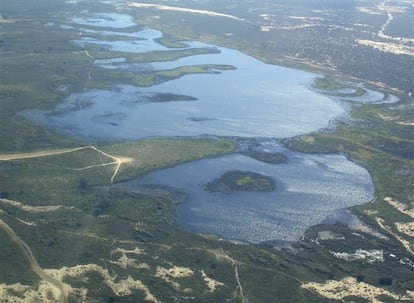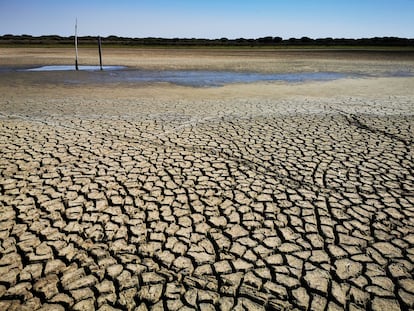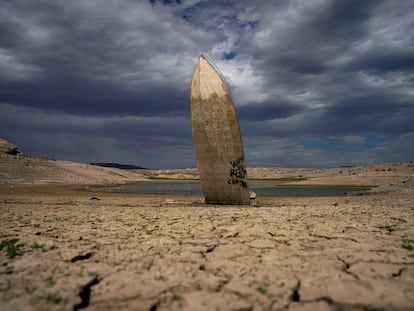Spain’s Doñana National Park dries up completely
The reserve’s last permanent freshwater lake, which had long resisted drought and illegal wells, has now disappeared

The last wetland to survive the tremendous drought that is ravaging Doñana National Park in southern Spain has disappeared this week. The protected area, one of the country’s most important natural reserves, declared a World Heritage Site by UNESCO, no longer has its own natural fresh water. The Santa Olalla lagoon, the largest of the permanent bodies of water, which quenches the thirst of thousands of migratory birds and mammals, has dried up, leaving the rest of the wetlands dry. It is one of many ravages caused by the lack of rain, which has harmed hundreds of species of fauna and vegetation, some of which may disappear.
“It is assumed that there is no water at all in the entire park. I have seen the deterioration over two months. The birds were gathering, and the lagoon was full of flamingos, until suddenly they all disappeared,” says biologist Carmen Díaz, a researcher at the Doñana Biological Station. Santa Olalla once covered 45 hectares. “Today there is a puddle of one meter by two meters,” she says.
Two years ago, the government declared the body of water “overexploited” and urged action to restore the water table of yesteryear. The Santa Olalla lagoon has only dried up twice before in recorded history, in 1995 and 1983, after several years of drought. In 2004, an AHS airborne sensor mapped Doñana and identified 2,867 bodies of water on the edge of the Guadalquivir river marsh. Nearly two decades later, all that water is gone. The lake’s disappearance is due both to drought and to the illegal wells for intensive strawberry farming and human consumption in the nearby resort town of Matalascañas.

This winter’s lack of rain was particularly dire for the reserve. It rained roughly half of what was expected. Over the last 40 years, an annual average of 540mm of rainfall has been recorded at Doñana, but between September 1, 2021 and May 31, the Palacio de Doñana station only detected 282mm of rainfall. Protected species such as the Iberian lynx, the imperial eagle and the spur-thighed tortoise suffer from the water shortage. The director of the Doñana Biological Station, Eloy Revilla, warns of the necessary shift that many sectors are putting off: “Doñana serves as a sentinel. First it passes through the most fragile areas, then into the marshlands where the harvests are already very poor. We humans will be next. Climate change makes less water available to us. We have to adapt now, not wait for calamities to arrive, to avoid traumatic effects on agriculture and industry.”
Biologists and hydrogeologists have warned since 1988 of the effects of Matalascañas, less than a kilometer from the northernmost lagoons of the reserve, and the illegal wells, which the Guadalquivir Water Authority rarely persecuted until 2019. Their warnings, however, fell on deaf ears. The aquifer of 2,409 square kilometers has large empty areas, as evidenced by the lagoons that have disappeared on the surface.
“The fauna of macrovertebrates is sustained by the lagoons, but if there are no shelters they go further or die. It is a loss of biodiversity for the whole of Europe. Everything that is strictly aquatic has died, including the eel, which is in danger of extinction, and other species of fish such as cornets and aquatic insects. Plants and amphibians may resist, but not for so long,” says Díaz from the Department of Wetland Ecology of the Doñana Biological Station, part of Spain’s National Research Council (CSIC). This summer, mammals have quenched their thirst at zacallones, small ditches dug by environmental technicians to provide artificial watering holes.
Santa Olalla has now become a dangerous quagmire for birds, who search for water but sink and get trapped. Díaz recounts how a colleague recently tried to save a flamingo chick at the bottom of the lagoon, but had to abandon the rescue because he himself was sinking in the mud. Meanwhile, a colt was trapped and attacked by vultures. The lagoon’s salinity is also now very high: a month ago it had 38 millisiemens per centimeter (the unit used by experts), compared to a normal level of 3 and a sea water level of 50.

The Water Authority, meanwhile, continues to seal off illegal wells in the region. Since 2018, environmental agents have closed 220 wells, but when they close one, the farmers tend to open up another. It pays off: the economic benefits of the strawberry harvest exceed the amount of the fines.
Matalascañas is supplied by five wells, which extract 2.75 cubic hectometres of water per year. Now authorities are planning to close the two closest wells to Doñana and open another two at the western end, in the direction of the city of Huelva. Have they reacted too late? “No action has been taken. In Matalascañas the grass continues to be watered and the swimming pools filled. There is no limitation on consumption,” Revilla says. Díaz clarifies: “Of course the extractions have an influence. We got [more water] because the golf course was closed. But we have to insist that the politicians give up their plans.”
The biologist is alluding to the plans of the conservative Popular Party (PP), which is in power in the southern region of Andalusia with an absolute majority. In January, the regional government presented a proposal to increase the irrigation of berries over 1,460 hectares on the edge of Doñana. The bill was rejected in the last elections in June, but the party expects to put it on the table again. The initiative comes despite the strong opposition of the European Commission –which threatened Spain with million-euro fines–, UNESCO, the Spanish Ministry of Ecological Transition, 25 scientific societies and 1,109 scientists and 23 European supermarket chains. The PP’s plans contravene the ruling of the Court of Justice of the European Union, which a year ago condemned Spain for failing to protect Doñana.
Regarding the plan, Revilla warns, “We cannot promise farmers that they will have more water and then let their companies collapse.” Díaz suggests a solution to stop the plans of the Andalusian right and save Doñana from the massive looting caused by the strawberry plantations and Matalascañas: “Regional premier Juan Manuel Moreno should come see what is there. Politicians only come to Santa Olalla when it is beautiful.”
Tu suscripción se está usando en otro dispositivo
¿Quieres añadir otro usuario a tu suscripción?
Si continúas leyendo en este dispositivo, no se podrá leer en el otro.
FlechaTu suscripción se está usando en otro dispositivo y solo puedes acceder a EL PAÍS desde un dispositivo a la vez.
Si quieres compartir tu cuenta, cambia tu suscripción a la modalidad Premium, así podrás añadir otro usuario. Cada uno accederá con su propia cuenta de email, lo que os permitirá personalizar vuestra experiencia en EL PAÍS.
¿Tienes una suscripción de empresa? Accede aquí para contratar más cuentas.
En el caso de no saber quién está usando tu cuenta, te recomendamos cambiar tu contraseña aquí.
Si decides continuar compartiendo tu cuenta, este mensaje se mostrará en tu dispositivo y en el de la otra persona que está usando tu cuenta de forma indefinida, afectando a tu experiencia de lectura. Puedes consultar aquí los términos y condiciones de la suscripción digital.
More information
Últimas noticias
Most viewed
- Sinaloa Cartel war is taking its toll on Los Chapitos
- Oona Chaplin: ‘I told James Cameron that I was living in a treehouse and starting a permaculture project with a friend’
- Reinhard Genzel, Nobel laureate in physics: ‘One-minute videos will never give you the truth’
- Why the price of coffee has skyrocketed: from Brazilian plantations to specialty coffee houses
- Silver prices are going crazy: This is what’s fueling the rally










































